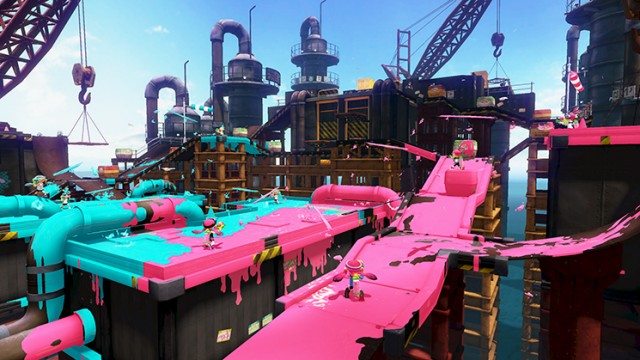
The launch of a brand new Nintendo IP is about as rare a Gold Mario Amiibo, so I jumped at the chance to partake in the Splatoon Global Testfire. Half beta test, half marketing event, the Testfire gave players the opportunity to try out the upcoming third-person shooter weeks ahead of launch. Unlike a typical demo, players were given limited and specific times in which they could try out the game’s primary Turf War online mode. Setting time aside for two of the play sessions, my five-year-old son and I eagerly logged on to see if Splatoon could join the likes of Mario Kart 8 and Super Smash Bros. as a Wii U must-have.
After beta testing several AAA FPS titles and a major MMO, I assumed that the first session of an online game made by a company not known for online games would be a hot mess. I was relatively shocked that, after two connection attempts, I was placed into a game completely free of bugs and lag. I’m absolutely gobsmacked that the likes of Activision and Microsoft, among others, have been thoroughly trounced by Nintendo. I have read several posts online about some having connection problems, but it seems like the exception rather than the norm.

Once placed into a game, eight players are sorted into two teams at random. Some have expressed frustration that if you are playing with a friend, there is a good chance that you won’t be on the same team. Perhaps this could be alleviated with a patch in the future, but the lack of voice chat makes it seem like Nintendo’s emphasis is on a simple, fun experience rather than hardcore team strategies. The inclusion of minigames between rounds rather than chat windows to communicate with your teammates certainly indicates that casual play will rule the day. Once the game has completed loading, the player is placed onto the battlefield and the fun begins.
Nintendo has been very vocal about pointing out how Splatoon is rather unique from most shooters. The goal is not to eliminate the other team, but cover the playing field with as much ink as possible. Players choose between three weapon types– Roller (short range, massive ink coverage), Splattershot (medium range, moderate ink coverage), and Charger (long range, minimum ink coverage)– that almost feel like classes. In my limited time with the game, it seemed like most players initially found it much more instinctive to try to blast players first and concentrate on ink coverage second. Splattershots and Chargers were seen all over the playing field.
As matches wore on, more players seemed to grasp the concept and there was a more methodical pace as players were trying to gain ground in the final minutes of the game. Rollers were the dominant force, almost to the point of feeling unbalanced. After getting plastered several times by Rollers, I adapted, staying high above the wide open spaces where Rollers couldn’t easily reach. After playing for a solid hour with no hiccups to speak of, I really never grew bored and was starting to see gameplay nuances that I didn’t see at first. The squid transformations really add a layer of stealth and speed that I didn’t see utilized by many players, either due to the newness of the game or the youth of the player base (my five-year-old simply wanted to paint everything).

Splatoon’s look is not going to be surprising to longtime Nintendo fans. Bright, colorful, stylized images are everything you’d expect in a Nintendo title. What is interesting is the definite attempt at establishing a consistent visual style much like Jet Set Radio, Space Channel 5, and even Street Fighter IV did in their days. The look is like ’90s Nickelodeon crossed with character designs ripped from a Pixar movie. The little Inklings will live very comfortably next to Mario, Samus, and the Animal Crossing Villagers. The ink splattered playfields are carefully designed with varied heights and surface types so that even when covered with ink, they are easy to understand, identify, and navigate. You can see faint ripples and movement in the ink, adding some liveliness to the levels, which could have become really repetitive due to the nature of the ink coverage. Sound design was also a high point. The rollers sound nice and squishy, Splattershots pop like paint guns, and the Inklings are bursting with personality and fun little vocal quirks. The soundtrack is distinctly Splatoon, very energetic and sprinkled with Inkling vocal cues. My son was humming the songs for the rest of the day. Nintendo really has done a fantastic job with the look and sound of Splatoon.
My son and I played two times during the event and both times were bummed when our hour sessions came to an end. Splatoon is like every Nintendo classic that has come before: simple, but deceptively deep and, above all, polished and fun. I think Nintendo has really tapped into something really special here.
The best way to describe Splatoon is that it truly is the Mario Kart of shooters. Fun, frantic, colorful, not very serious, Splatoon redefines the aesthetics and nature of an online shooter in many of the same ways that Super Smash Bros. did with fighters. It truly does feel like the third tier of a careful strategy to Nintendo’s approach to three very popular genres. Release day cannot come soon enough!




 ShareThis
ShareThis






